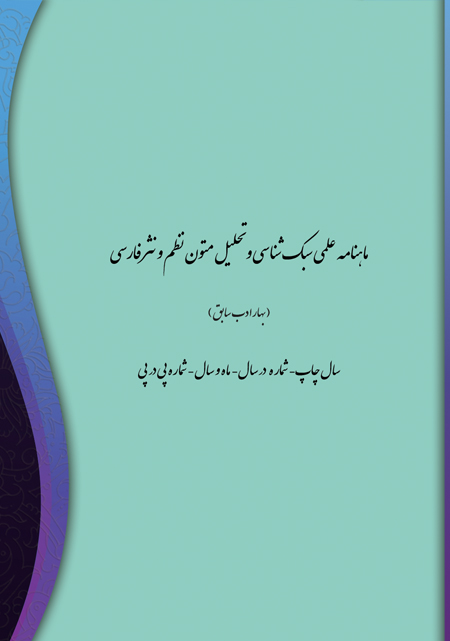- Count View : 5
- آدرس کوتاه شده مقاله: https://bahareadab.com/article_id/1872
- کد doi مقاله: Doi: 10.22034/bahareadab.2025 .18 .7907
Journal of the stylistic of Persian poem and prose
volume Number 18،
number In Volume 6،
،
issue Number 112
Introduction & Stylistic analysis Of Divan -e- Bibi Yamani
Elham Bavaghar Zaeimi (Author in Charge), Morteza Rashidi Ashjerdi
Abstract
BACKGROUND AND OBJECTIVES: Persian literature during the Safavi period, although influenced by patriarchal structure and specific religious policies, the valuable works of some female poets, such as the Yamani Bibi, were preserved in the form of manuscripts. The aim of this study is to introduce and examine the uncorrected Divan-e- Bibi Yamani, analyze the stylology and examine its obvious and implicit intertextuality with Ghazaliat Shams.
METHODOLOGY: The present study was conducted in a descriptive–analytical manner based on a manuscript in the library of the University of Tehran to No. 7777. In this analysis, the poet"s linguistic, rhetorical and intellectual levels and innovations in the Bibi Yamani ‘s Divan have been examined and his imitations of Ghazaliat-e- Shams have been compared with the intertextual approach.
FINDINGS: Bibi Yamani"s Divan contains about 6723 verses. It can be said with confidence that Bibi Yemeni is the first woman to write more than 400 ghazals in praise of Shams Tabrizi and in imitation of Shams" ghazals. In these ghazals, mystical and lyrical concepts have been recreated in feminine language. The linguistic features of his poetry, such as meter variation, verb rows, and simple syntactic structure, along with mystical themes such as annihilation, connection, and unity of being, indicate the poet"s conscious and creative influence on Ghazaliat –e-Shams. In addition, the poet has added to the richness of his poems by using explicit and implicit intertextual functions and by the colorful presence of feminine elements and personal expression.
CONCLUSION: Bibi Yamani"s Divan contains 478 ghazals, 2 quatrains, and one single verse. The language of her poems is simple and free from the functions of the Khorasani style. Her poetic style, due to her reception of Ghazaliat –e-Shams and the proximity of her language, the way of using literary devices, and her intellectual themes to this work, is a literary return. Among the verbal and spiritual literary devices, repetition and allusion, respectively, have had the highest frequency in the text. Allusions are often of the verb type, similes are of the detailed, metaphors are of the epithet type, and metaphors are used to relate the part to the whole. Lyrical themes such as mourning songs, hymns, and expressions of the pain of love and separation, and mystical themes such as annihilation, unity of existence, longing for union, and love are among the most important themes raised in Bibi Yamani"s Divan. Also, Bibi Yamani"s conscious adherence to Ghazaliat-e-Shams and her feminine perspective on mystical concepts has enabled her to introduce an independent and original voice into Persian literature while preserving the core elements of classical ghazals.
Keyword
Bibi Yamani’s Divan
, Manuscript
, bazgasht Style
, Safavi period
, Intertextuality.
- Afshar, I. (2005). Codicology and Bibliography. Tehran: Toos Publishing. p. 97.
- Azarnoush, Azartash. (2008). History of Persian Language and Literature in the Safavid Period. Tehran: SAMT. p. 183.
- Daneshpazhouh, M. (1960–1985). Catalogue of Manuscripts of the University of Tehran. Vol. 16. Tehran: Central Library of the University of Tehran. p. 696.
- Faqihi Moghadass, N. (2018). The Role of Shia Women in the Expansion of Islamic Sciences and Civilization. Tehran: Imam Ali Publications, Vol. 1. p. 269.
- Haravi, N. (1970). History of Khan Jahan and Makhzan Afghani, edited by Seyed Mohammad Emamuddin. Pakistan: Zico Press. pp. 1-18.
- Hejazi, B. (2023). History of No One. Tehran: Qasideh Sara. p. 43.
- Kazazi, J. (1989). Aesthetics of Persian Speech, Bayan (1). Tehran: Markaz Publishing. pp. 68, 72-73.
- Kristeva, J. (1980). Desire in Language: A Semiotic Approach to Literature and Art. Edited by Leon S. Roudiez, translated by Thomas Gora et al. Columbia University Press, PP:69-66.
- Mehri, N. (2011). “Women Poets of the Safavid Era: A Review of Sources and Texts.” Quarterly Journal of Women’s Studies in Culture and Art, Vol. 3, No. 2, pp. 55-72.
- Mirzaei, M, Hasan; Khosravi, M (2019). “A Historical Study of Amir Chakhmaq Complex in Yazd and the Role of Bibi Fatemeh Khatun Yemeni in Its Formation.” Scientific-Research Quarterly of Islamic History Studies, Vol. 11, No. 41, pp. 1-18.
- Modarresi Chahardahi, M. (2005). Religious Poetry in Iran. Tehran: Ettelaat. p. 251.
- Molavi, J. (1988). The Collected Works of Shams Tabrizi. Edited by Badi’ozaman Foruzanfar. Tehran: Amir Kabir. p. 244.
- Nafisi, S. (1996). History of Persian Poetry and Prose in Iran up to the End of the 10th Century AH. Tehran: Ferdows. p. 212.
- Rajabi, M. (1995). Famous Iranian and Persian-speaking Women from the Beginning until the Constitutional Era. Tehran: Soroush. p. 38.
- Sadeghi, N. (2016). “Colloquial Language in Classical Women’s Poetry.” Research in Persian Language and Literature, No. 27, pp. 75-90.
- Safavi, K. (2003). Introduction to Stylistics. Tehran: Elmi va Farhangi Publishing. p. 11.
- Shafiei Kadkani, M. (1999). Music of Poetry. Tehran: Agah Publishing. p. 22.
- ________________. (2007). With Lamp and Mirror. Tehran: Sokhan. p. 29.
- _________________.. (2004). Imagery in Persian Poetry. 9th edition. Tehran: Agah. p. 413.
- Shamisa, S. (2003). Stylistics of Poetry. 9th edition. Tehran: Ferdows. pp. 233, 319.
- Soltanpour, Abbas; Farzi, Hamidreza; Dehfan, Ali. (2020). “An Intertextual Study of Quranic References in Maqamat-e-Hamidi.” Journal of Stylistics of Persian Poetry and Prose (Bahar-e-Adab), Vol. 11, No. 57, pp. 91–112.
- Tahmasebi, S. (2005). “The Role of Provincial Viziers in the Safavid Government.” Journal of History Researchers, Vol. 2, No. 4, pp. 40-53.
- Yamani, Bibi (1097 AH). Divan of Bibi Yamani. Manuscript. No. 7777. Tehran: Documentation Center and Central Library of the University of Tehran.
- Zarrinkoub, A. (1999). With the Caravan of Hilla. Tehran: Sokhan. pp. 158, 392.

